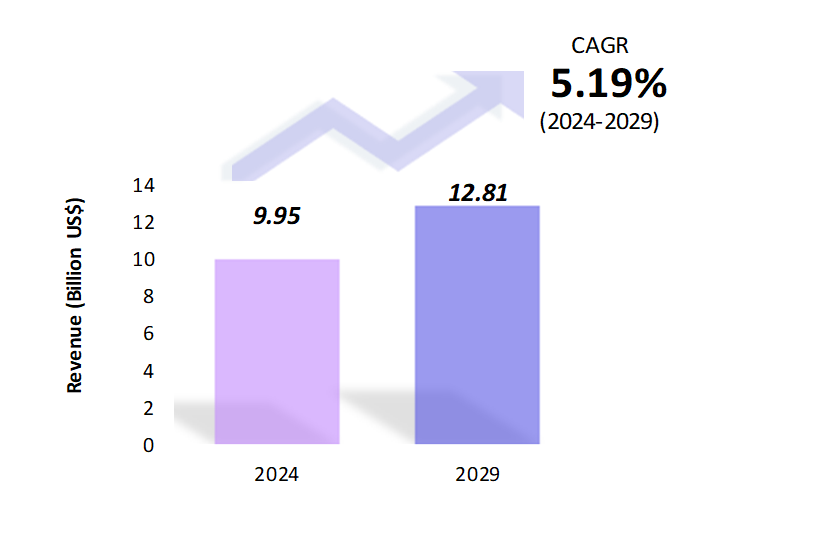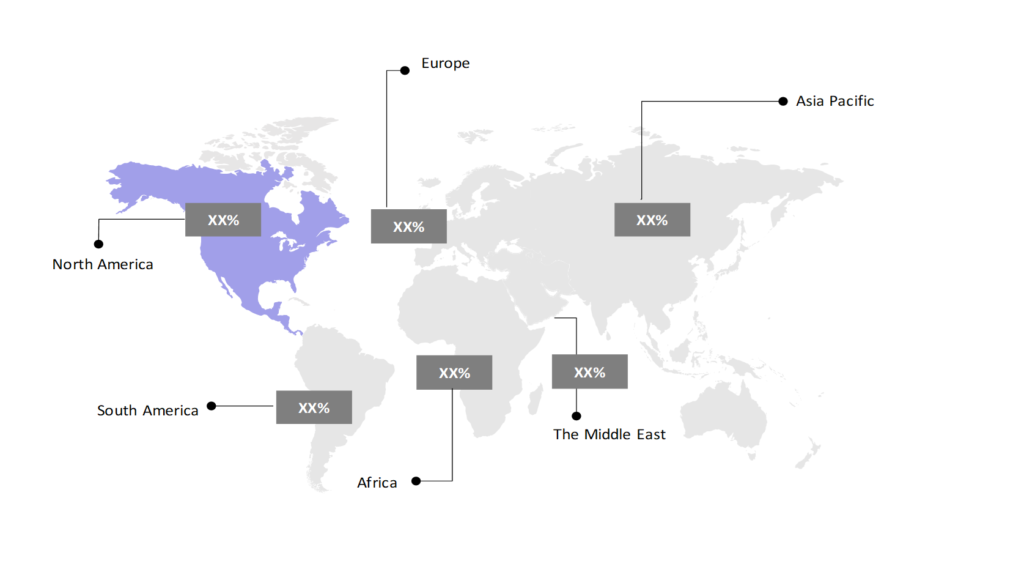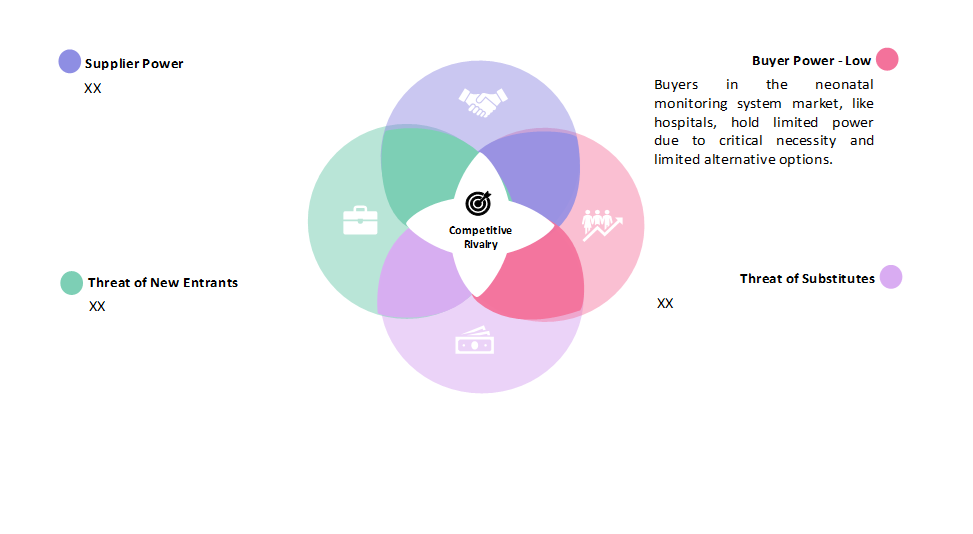Neonatal Monitoring System Market: Size, Share, Trends & Forecast (2024-2029)
The report covers a comprehensive analysis segmented by Product (Blood Pressure Monitors, Cardiac Monitors, Pulse Oximeters, Capnographs, Integrated Monitoring Devices), By Type (Audio Baby Monitor, Video Baby Monitor), By End User (Hospitals, Child Care Clinics, Others), By Geography (North America, South America, Asia Pacific, Europe, The Middle East, Africa).
Neonatal Monitoring System Market Snapshot

Neonatal Monitoring System Market Overview
The global neonatal monitoring system market is estimated to be at $9.95 Bn in 2024 and is anticipated to reach $12.81 Bn in 2029. The global neonatal monitoring system market is registering a CAGR of 5.19% during the forecast period 2024-2029.
The market for neonatal monitoring systems is expanding significantly due to several causes. To evaluate a newborn’s health and quickly identify any anomalies or difficulties, neonatal monitoring systems are essential. Vital sign monitoring devices, such as heart rate, respiration rate, temperature, and oxygen saturation, are commonly included in these systems. A principal factor propelling the market’s expansion is the global rise in the number of preterm births and neonatal problems. Advances in medical technology have improved the survival rates of preterm infants, which has led to an increase in demand for sophisticated monitoring systems to handle their complicated healthcare needs.
Technological developments are essential to the growth of markets. New developments include wearable sensors, wireless connectivity, and real-time data analysis tools to improve the precision and effectiveness of neonatal monitoring. Furthermore, predictive analytics and individualized care are made possible by the combination of artificial intelligence (AI) and machine learning algorithms, which increase market demand. The increasing emphasis on enhancing maternity and child healthcare services, encouraged by government programs and expenditures in healthcare infrastructure, also impacts the market. Encouraging more parents and healthcare professionals to embrace neonatal monitoring, awareness campaigns, and educational initiatives about its significance supports market expansion. Regulatory obstacles, concerns about data security and privacy, high costs of sophisticated monitoring devices, and problems with system interoperability are some of the barriers the market must overcome.
To assure the affordability, efficacy, and safety of newborn monitoring systems, healthcare stakeholders, legislators, technology developers, and regulatory authorities must work together to address these difficulties. Despite these challenges, it is projected that the market for neonatal monitoring systems would expand as long as the healthcare industry continues to prioritize the health and welfare of infants.
Neonatal Monitoring System Market Coverage
| Historical & Forecast Period | 2018-2029 |
| Base Year | 2023 |
| Forecast Period | 2024-2029 |
| Units | Billion US$ |
| Segments | Product, By Type, End User |
| Geographies | North America, South America, Asia Pacific, Europe, the Middle East, Africa |
| Key Vendors |
Medtronic plc, Siemens Healthineers AG, OMRON Healthcare, Inc., TELEFLEX Inc., Masimo Corp. |
Key Geographies of Neonatal Monitoring System Market, 2023

Porter’s 5 Forces Analysis of Neonatal Monitoring System Market

Neonatal Monitoring System Market Trends
Several significant developments are fueling the market boom for neonatal monitoring. Improvements in technology are making monitoring equipment more accurate and effective. Neonatal monitoring systems are progressively incorporating innovations like wearable sensors, wireless connectivity, and remote monitoring capabilities, which allow for real-time data collecting and analysis. Healthcare professionals are investing in innovative monitoring equipment to closely monitor vital signs and quickly identify any anomalies due to a growing focus on improving the results of neonatal care. Additionally, handheld and portable monitoring equipment is growing, making it easier to continuously monitor newborns even when they are not in traditional clinical settings. This trend is especially important in developing countries, where access to medical services may be restricted.
Furthermore, data analysis and interpretation are being revolutionized by the incorporation of artificial intelligence (AI) and machine learning algorithms into newborn monitoring systems. Algorithms driven by AI can help medical practitioners spot trends, anticipate problems, and give newborns individualized treatment. The COVID-19 pandemic has emphasized the value of remote patient monitoring, which has accelerated the deployment of telehealth technologies in the field of newborn care. Remote monitoring and virtual consultations allow medical professionals to care effectively while lowering the chance of contracting infectious infections.
With the integration of AI and telehealth technologies, the rise in newborn problems, the need for portable monitoring solutions, and technical breakthroughs driving growth, the neonatal monitoring market is expected to increase significantly in the coming years. The market for neonatal monitoring devices is anticipated to grow over the next several years as the healthcare sector continues to place a high priority on the health and well-being of newborns.
Neonatal Monitoring System Market Driving Factors
Numerous important factors influence the neonatal monitoring market and determine its trajectory of growth. A major cause is the rising incidence of preterm births and neonatal problems worldwide. Premature newborn survival rates are increasing thanks to medical intervention improvements, and managing the intricate healthcare requirements of these vulnerable neonates is becoming more dependent on advanced monitoring systems. The development of recent technologies is essential to the expansion of the market. New developments in monitoring technology, including wearable sensors, wireless connectivity, and real-time data analysis capabilities, improve the precision and effectiveness of newborn care.
In addition, growing healthcare costs, especially in developing nations, support market growth. Neonatal monitoring devices are more likely to be used when the healthcare system gets better and the government helps improve healthcare for moms and babies. Moreover, market demand is driven by parents’ and healthcare professionals’ increasing knowledge of the value of ongoing monitoring in neonatal care. The benefits of early detection and intervention in improving newborn outcomes are becoming more widely acknowledged, due to awareness campaigns, educational initiatives, and lobbying efforts. Further propelling market expansion is the COVID-19 pandemic’s acceleration of telehealth solution usage, which includes remote neonatal monitoring. Healthcare providers can give timely interventions while reducing physical contact with patients because of virtual consultations, remote monitoring platforms, and telemedicine technologies. This is especially important during a pandemic.
In summary, the market for neonatal monitoring is influenced by several variables, including rising newborn problems, technological advancements, the expansion of healthcare infrastructure, rising public awareness, and the uptake of telehealth services. Together, these factors support the market’s growth trajectory, and further growth is anticipated soon.
Neonatal Monitoring System Market Challenges
Numerous obstacles could hinder the market for neonatal monitoring’s expansion and uptake. The expensive price of sophisticated monitoring equipment is a barrier, especially in low-resource environments or developing nations with constrained healthcare budgets. This limits the availability of technologies for newborn care, impeding thorough monitoring and prompt interventions. Problems with compatibility between various monitoring systems might make it difficult to integrate and communicate data, which can result in inefficiencies and even mistakes when making clinical decisions. This problem is made worse by the lack of uniformity in data formats and protocols.
Innovative monitoring solutions for neonatal care may also take longer to reach the market as a result of regulatory obstacles and rigorous approval procedures for new medical devices. To further foster confidence between patients and healthcare professionals, issues with data privacy, security, and liability in the context of telehealth and remote monitoring systems must be resolved. Furthermore, a lack of knowledge and instruction on the use and interpretation of data from sophisticated monitoring systems among medical professionals may restrict their efficacy in clinical practice. Healthcare stakeholders, legislators, technology developers, and regulatory agencies must work together to address these issues to guarantee data security, affordability, interoperability, regulatory compliance, and training for healthcare professionals in newborn monitoring techniques.
Neonatal Monitoring System Market – Key Industry News
- In February 2024, Infosys Foundation announced its collaboration with the Centre for Cellular and Molecular Platforms (C-CAMP) to launch the C-CAMP-Infosys Foundation Project. As part of this project, fetal monitoring technology will be deployed to enhance health monitoring of expectant mothers across district hospitals and community health centers, in Karnataka. which is aimed at strengthening maternity care, both for expectant mothers and newborns.
- In August 2023, Masimo Corp., a health technology and consumer electronics company based in Irvine California, has launched the Stork smart home baby monitoring system. Stork offers a range of innovative features, including Continuous tracking of health data.
- In August 2023, Medical and laboratory products provider Cardinal Health Inc. has Introduced its next-generation medical device, NTrainer System 2.0, for premature and newborn infants.
Neonatal Monitoring System Market Competitive Landscape
The participants in the global neonatal monitoring system industry are always developing their strategies to preserve a competitive advantage. Companies primarily use acquisitions, R&D, partnerships, and technological launches. Several important entities in the neonatal monitoring system market include Medtronic plc, Siemens Healthineers AG, OMRON Healthcare,Inc., TELEFLEX Inc., Masimo Corp., and others.
Continuous technological advancements, increasing demand for portable monitoring devices, and growing investments in healthcare infrastructure fueling the competition. Factors such as government initiatives to improve healthcare infrastructure, increasing neonatal mortality rates, and the rising prevalence of preterm births are fueling market competition as companies vie to capture a larger market share. However, stringent regulatory requirements and high capital investments pose challenges for new entrants. Overall, the neonatal monitoring system market remains dynamic and competitive, characterized by continuous technological advancements and strategic collaborations.
Neonatal Monitoring System Market Company Share Analysis, 2023(%)

Neonatal Monitoring System Market – Key Companies

Reason to Buy from us

Table of Contents
| 1. Introduction |
|---|
| 1.1. Research Methodology |
| 1.2. Scope of the Study |
| 2. Market Overview / Executive Summary |
| 2.1. Global Neonatal Monitoring System Market (2018 – 2022) |
| 2.2. Global Neonatal Monitoring System Market (2023 – 2029) |
| 3. Market Segmentation |
| 3.1. Global Neonatal Monitoring System Market by Product |
| 3.1.1. Blood Pressure Monitors |
| 3.1.2. Cardiac Monitors |
| 3.1.3. Pulse Oximeters |
| 3.1.4. Capnographs |
| 3.1.5. Integrated Monitoring Devices |
| 3.2. Global Neonatal Monitoring System Market by Type |
| 3.2.1. Audio Baby Monitor |
| 3.2.2. Video Baby Monitor |
| 3.3. Global Neonatal Monitoring System Market by End User |
| 3.3.1. Hospitals |
| 3.3.2. Child Care Clinics |
| 3.3.3. Others |
| 4. Regional Segmentation |
| 4.1. North America |
| 4.1.1. The U.S |
| 4.1.2. Canada |
| 4.1.3. Mexico |
| 4.2. South America |
| 4.2.1. Brazil |
| 4.2.2. Argentina |
| 4.2.3. Colombia |
| 4.2.4. Chile |
| 4.2.5. Rest of South America |
| 4.3. Asia Pacific |
| 4.3.1. China |
| 4.3.2. India |
| 4.3.3. Japan |
| 4.3.4. South Korea |
| 4.3.5. Rest of Asia Pacific |
| 4.4. Europe |
| 4.4.1. UK |
| 4.4.2. Germany |
| 4.4.3. Italy |
| 4.4.4. France |
| 4.4.5. Spain |
| 4.4.6. Rest of Europe |
| 4.5. The Middle East |
| 4.5.1. Turkey |
| 4.5.2. UAE |
| 4.5.3. Saudi Arabia |
| 4.5.4. Rest of the Middle East |
| 4.6. Africa |
| 4.6.1. Egypt |
| 4.6.2. South Africa |
| 4.6.3. Rest of Africa |
| 5. Value Chain Analysis of the Global Neonatal Monitoring System Market |
| 6. Porter Five Forces Analysis |
| 6.1. Threats of New Entrants |
| 6.2. Threats of Substitutes |
| 6.3. Bargaining Power of Buyers |
| 6.4. Bargaining Power of Suppliers |
| 6.5. Competition in the Industry |
| 7. Trends, Drivers and Challenges Analysis |
| 7.1. Market Trends |
| 7.1.1. Market Trend 1 |
| 7.1.2. Market Trend 2 |
| 7.1.3. Market Trend 3 |
| 7.1.4. Market Trend 4 |
| 7.1.5. Market Trend 5 |
| 7.2. Market Drivers |
| 7.2.1. Market Driver 1 |
| 7.2.2. Market Driver 2 |
| 7.2.3. Market Driver 3 |
| 7.2.4. Market Driver 4 |
| 7.2.5. Market Driver 5 |
| 7.3. Market Challenges |
| 7.3.1. Market Challenge 1 |
| 7.3.2. Market Challenge 2 |
| 7.3.3. Market Challenge 3 |
| 7.3.4. Market Challenge 4 |
| 7.3.5. Market Challenge 5 |
| 8. Regulatory Landscape |
| 9. Competitive Landscape |
| 9.1. Medtronic Pvt, Ltd. |
| 9.2. Siemens Healthineers AG |
| 9.3. OMRON Healthcare, Inc. |
| 9.4. Teleflex Medical Pvt Ltd. |
| 9.5. Masimo Corp. |
| 9.6. Company 6 |
| 9.7. Company 7 |
| 9.8. Company 8 |
| 9.9. Company 9 |
| 9.10. Company 10 |
Neonatal Monitoring System Market – Frequently Asked Questions (FAQs)
What is the current size of the global neonatal monitoring system market?
The market size for the global neonatal monitoring system market in 2024 is $9.95 Bn.
Who are the major vendors in the global neonatal monitoring system market?
The major vendors in the global neonatal monitoring system market are., Medtronic plc, Siemens Healthineers AG, OMRON Healthcare, Inc., TELEFLEX Inc., Masimo Corp.
Which segments are covered under the global neonatal monitoring system market segments analysis?
This report offers in-depth insights into each product, by type, and end user.
